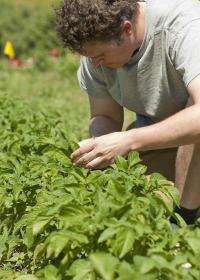'Balanced' ecosystems seen in organic ag better at controlling pests

There really is a balance of nature, but as accepted as that thought is, it has rarely been studied. Now Washington State University researchers writing in the journal Nature have found that more balanced animal and plant communities typical of organic farms work better at fighting pests and growing a better plant.
The researchers looked at insect pests and their natural enemies in potatoes and found organic crops had more balanced insect populations in which no one species of insect has a chance to dominate. And in test plots, the crops with the more balanced insect populations grew better.
"I think 'balance' is a good term," says David Crowder, a post-doctorate research associate in entomology at Washington State University. "When the species are balanced, at least in our experiments, they're able to fulfill their roles in a more harmonious fashion."
Crowder and colleagues here and at the University of Georgia use the term "evenness" to describe the relatively equal abundance of different species in an ecosystem. Conservation efforts more typically concentrate on species richness—the number of individual species—or the loss of individual species. Crowder's paper is one of only a few to address the issue. It is the first the first to look at animal and fungal communities and at multiple points in the food chain.
The researchers say their results strengthen the argument that both richness and evenness need to be considered in restoring an ecosystem. The paper also highlights insect predator and prey relationships at a time when the potato industry and large French fry customers like McDonald's and Wendy's are being pushed to consider the ecological sustainability of different pest-control practices.
Conventional pest-management on farms often leads to biological communities dominated by a few species. Looking at conventional and organic potato farms in central Washington State's Columbia Basin, Crowder found that the evenness of natural pests differed drastically between the two types of farms. In the conventional fields, one species might account for four out of five insects. In the organic fields, the most abundant species accounted for as little as 38 percent of a field's insect predators and enemies.
Using field enclosures on Washington State University's Pullman campus, Crowder recreated those conditions using potato plants, Colorado potato beetles, four insect species and three soil pathogens that attack the beetles. When the predators and pathogens had similar numbers, says Crowder, "we would get significantly less potato beetles at the end of the experiment."
"In turn," he adds, "we'd get bigger plants."
Crowder says he is unsure why species evenness was lower in conventional crops. It could be from different types of fertilization or from insecticides killing some natural enemies more than others.
Provided by Washington State University
















